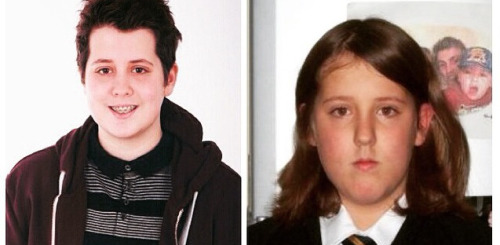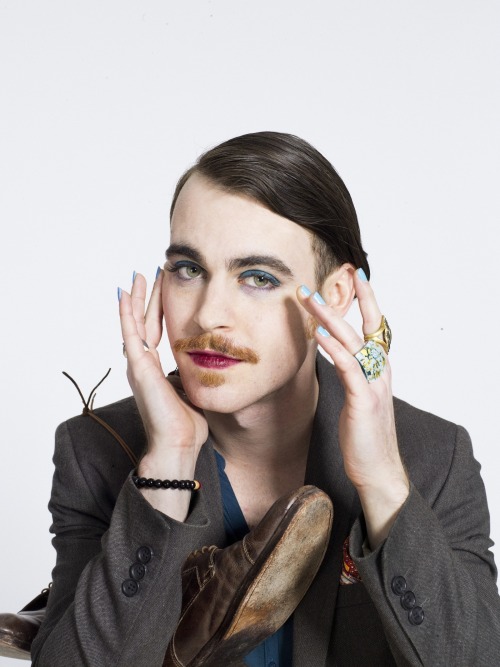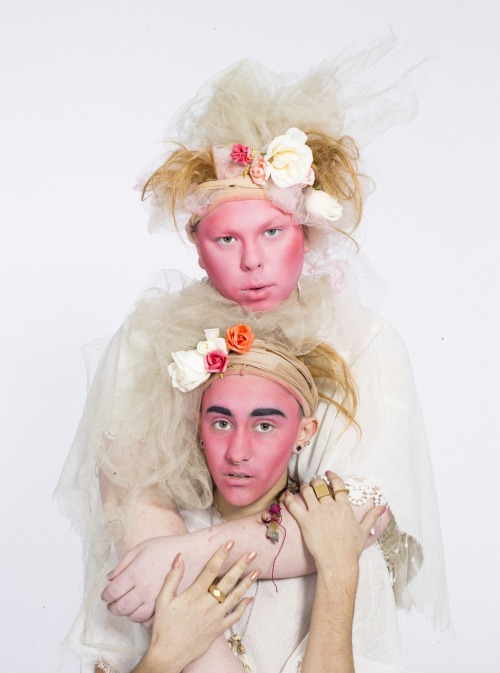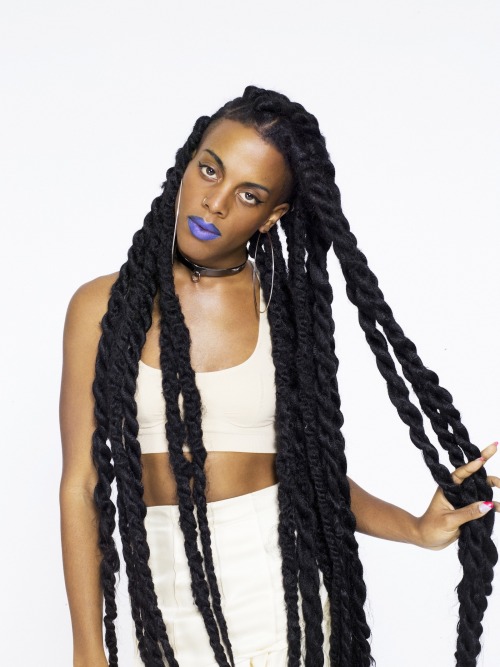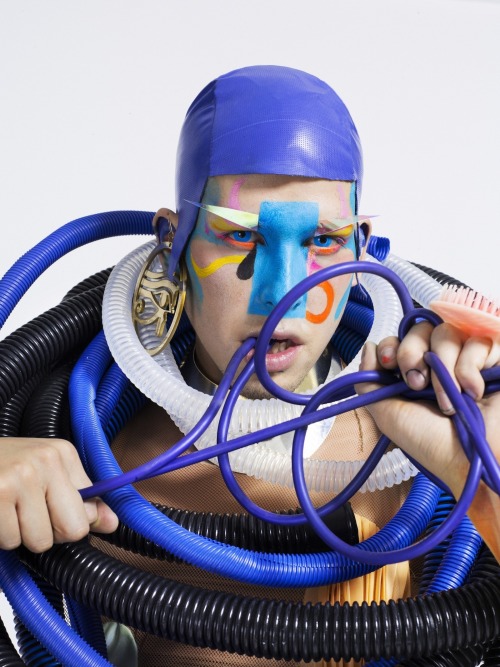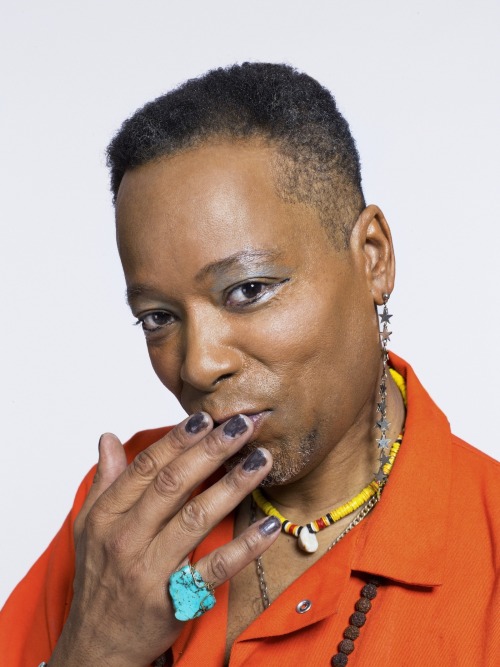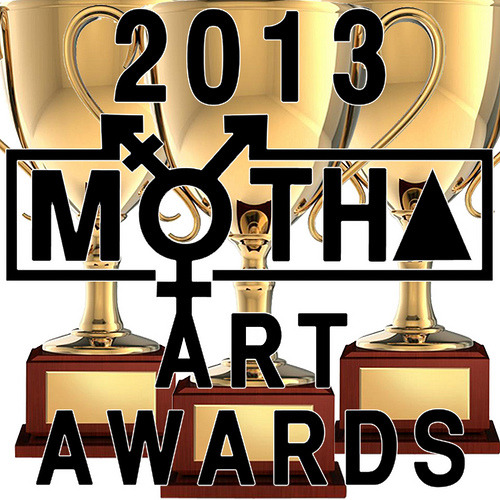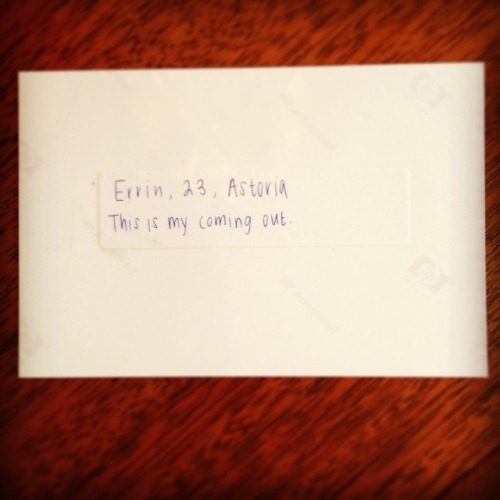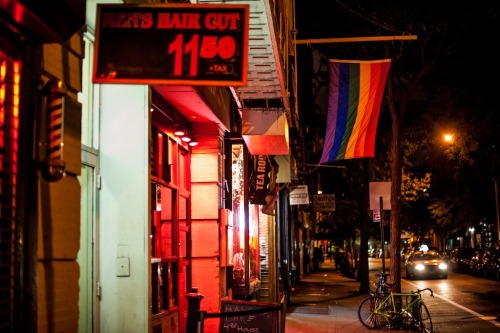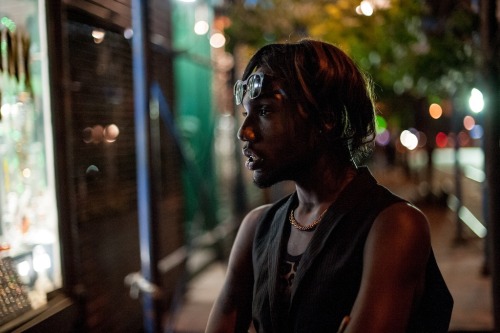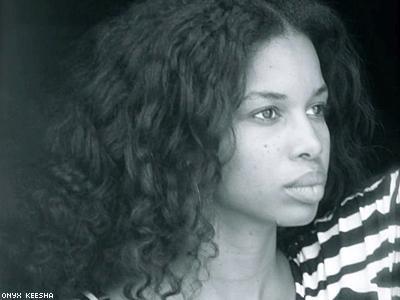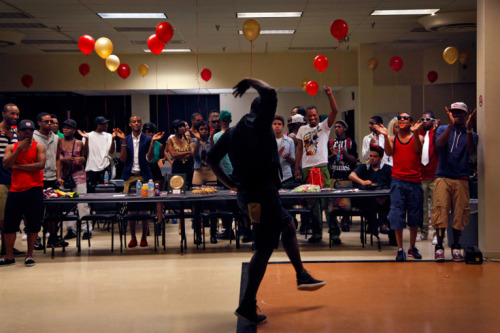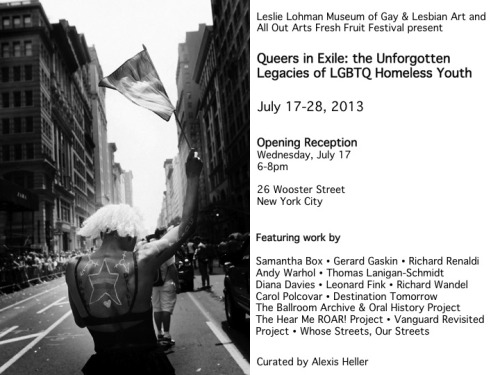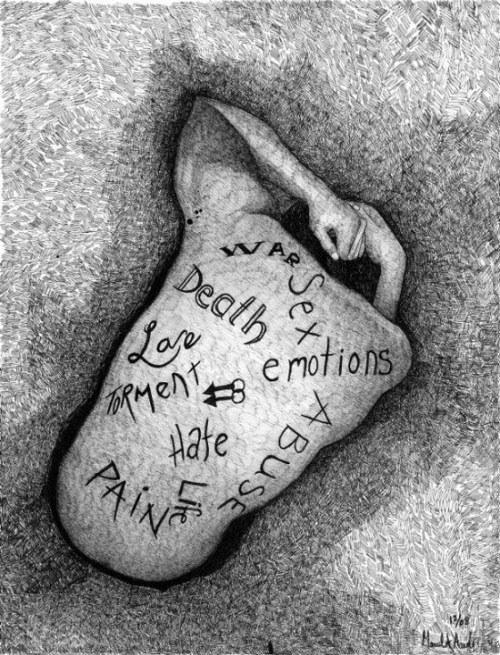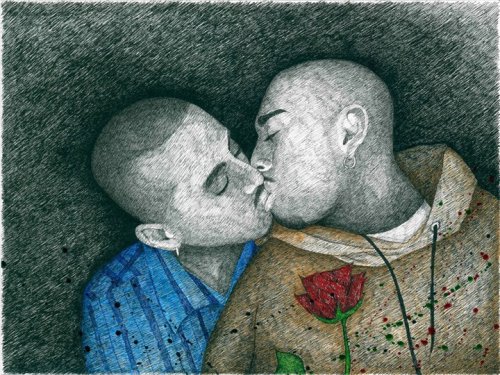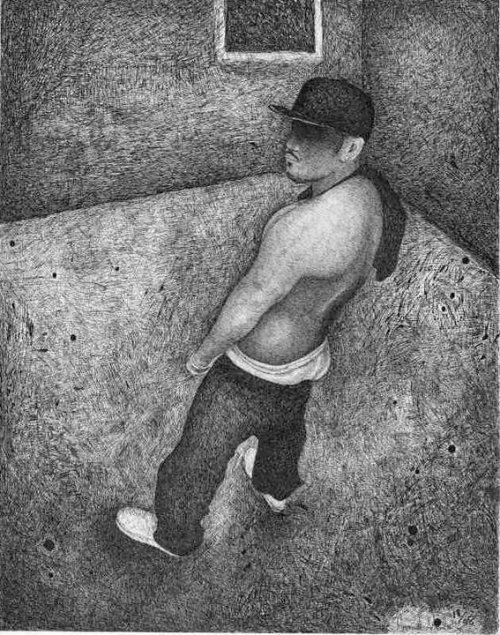#myqueertestimony
Submitted by ALEX JONES, Age 17, South Wales
Titled: “It’s Crazy How One Year You Think ‘I Am Never Going To Make It Out Alive’ To Think ‘I Can Make These Dreams Come True”
right photo – 11 years old (first day of high school): Unfortunately i remember this age so so well. it was months/weeks after i wrote my first suicide note saying i was going to kill myself, i clearly wasn’t in the correct mind frame or whats so ever, it was just after puberty kicked in and i wasn’t happy at all, i was always sad, i had no friends, my mum was divorcing my dad and i was in pieces. moving 300 miles away from the place you grew up and where you lived was hard for me. I refused to wear a bra, i refused to knowledge that i was beginning to become a female. as it didn’t feel right, i didn’t feel comfortable and i was having little dysphoria moments. At this time i was just an alone kid and I wasn’t prepared for puberty as I hadn’t been taught it before. i hated the fact that i was becoming someone who I didn’t recognise. But for the sake of my family and bullying i didn’t tell anybody how i felt, because who would believe a 11-year-old tom boy when she says ‘i feel like a boy’, nobody.
left photo – 17 years old (half way through college): At the age of 15 i turned around to my friends and told them that i was transgender, in fact it was the 20th of February 2013! i had this massive weight taken off my shoulder, after years of self harming, drug taking, smoking and suicidal thoughts i thought i may as well be open with life and that’s when my deep and darkest fear became public. That day i lost some friends because of it but my real ones have stuck by me throughout it all and are still here today. I chose the name Alex and began introducing myself to others and they started to click on pretty quick. Since that day ive been so happy and so so thankful. I remember when the teachers found out that i was trans, some of them didn’t react too well and some of them didn’t care, for example my old maths teacher Mr Baker said straight away that he’d call me Alex and use male pronouns and not once did he mess up, he was the most respectful teacher in the high school i went too. This new year i came out to EVERYBODY in my family and since that day, they’ve respected my name change and they’ve respected that i am trans and they use the correct pronouns, i never imagined my family being like this, but then again i’m still going to be the kid of the family who always ends up in trouble or who tells terrible jokes, i’m just being honest and doing and being who i am in life, because i don’t want to be sad, depressed, suicidal or i don’t want to harm myself over something that can possible be helped. i’m just over 1 year and six months clean now and i cant even express how it feels. i feel like i’m beginning to be the person god intended me to be, i understand that this is such a long and hard-working process but i wake up everyday purely because i know that one day, ill be a true son, a true brother, a true nephew, a true grandson and possible a dad and a husband (i hope!). if someone said to me 2 years ago ‘Alex, you’ll be happier, you’ll be alive and you’ll be making the most of your life, you’re in college and you’re doing some amazing things for the transgender community and you’re free and open’ i would have never believed them in a million years, because i suffered with isolation for 4 years, but now, i’m alive and i’m happy.
i’m one thankful young man right now <3
About the artist:
MY NAME IS ALEX JONES. I’M A 17 YEAR OLD TEENAGER FROM WALES! I’M TRANSGENDER AND PROUD, WITHIN MY LIFE I’D LOVE TO INSPIRE AND HELP OTHER YOUNG PEOPLE WHO AREN’T HAVING A POSITIVE TIME IN LIFE. I WANT TO SHOW AND TELL THEM THAT ONE DAY IT WILL BE OKAY AND I AM DETERMINED TO MAKE SURE MY DREAM BECOMES A REALITY!
Connect with more of Alex’s writing at: www.happinesswillcomesoon.wordpress.com
Post link
Testimony by BIZZY BAREFOOT, MARS HOBRECKER, BLUSH CASSIDY, LEAH JAMES, GAGE OF THE BOONE, JULIANA HUXTABLE, PEEWEE NYOB, and JACK WATERS, New York
Titled:the colorful activism of new york’s most radical queers
As Bruce Jenner prepares to share his transition with the world, Sam Smith goes platinum amidst a subtle coming-out, and LGBT characters drive storylines on beloved television shows like ‘Orange is the New Black’ and 'Transparent’, homosexual and transgender identities are playing increasingly influential roles within mainstream pop culture. These changes reflect shifting politics worldwide, with gay marriage legalized in the U.K. and many U.S. states. Yet there is a strong, insistent subcurrent within queer communities that resists rites of passage like walking down the aisle and enlisting into the military. Call them the radical queers, and know that the term is flexible, and evolving. From the local gardens of the East Village to Bushwick warehouses, a new wave of New York artists and activists young and old are banding together to question and redefine what it means to be queer today.
Twenty years ago, Jack Waters and Peter Cramer created a radical sanctuary in the form of a community garden called Le Petit Versailles. With its psychedelic art installations and freeform events, the East 2nd Street plot is a slice of the old, pre-Bowery Hotel Alphabet City. Jack and Peter met in 1980 through the art and activism collective ABC No Rio, still a downtown institution hosting hardcore punk Saturday matinees and poetry readings.
These two are elders in a loose community that also includes young artists Michael Bailey Gates (who photographed his extended creative family for this story), Mars Hobrecker and Leah James, artist Bizzy Barefoot, artist and DJ Juliana Huxtable, activist and Wild Ponies film collective member Connor Donahue (aka Blush Cassidy), and Gage of the Boone, founder of queer art space Spectrum. They’re joined by an endlessly expanding cast of characters that meet at Bizzy’s house in Brooklyn, through the MIX NYC queer film festival, at Le Petit Versailles, on the Internet. Where you probably won’t find them is at the yearly Gay Pride parade, which several dismiss as being too commercial. Some are radical faeries (a faction founded in 79 by Harry Hay, with pagan-spiritual elements and remote sanctuary camps), some are not. They’re all artists in some way or another, and activists with counter-culture leanings, fighting for causes from green space to health care to youth art. You could call them “anti-assimilationist”, as the Radical Queer Reddit bio does. Or you could just listen to what they have to say.
Published by i-D, 3/27/15
Post link
Testimony by K, United States
Interviewer: Cristan Williams
CW: How long have you been involved with sex work?
K: I’ve been in different types of sex work and I think that it’s important to that there is a difference between cam work, street work, escort work and other types of sex work.
When I initially got involved with sex work it was as a street worker. It was done out of necessity. I was a teen and I was homeless. I turned to sex work as a means to survive. Through doing that I ended up in what I realize now as a form of trafficking. At that time I didn’t realize that I was a victim of trafficking. I didn’t understand that being shared among a group as a teen was trafficking. So, for me, that experience was not at all comparable to what I do now.
What I do now is work through an escort agency. I get to pick my clients. I meet with them and we engage in a theme that is already predetermined. I meet my clients as a character I have created for them. I have also done porn work and I have done some dominatrix work as well.
CW: Speaking in terms of broad brush categorizations, feminism offers various frameworks to conceptualize sex work. Generally speaking, some second wave feminist framework views sex work as a type of rape in that people usually don’t do sex work without being pressured – either economically, through relationships, etc – into sex work. Since being coerced into sex acts is rape, sex work is viewed as being one of patriarchy’s most effective forms of subjugation. Moreover, the sex industry can be viewed as the DNA of patriarchy in that every form of female subjugation is sexualized. Other forms of feminism are more discursively focused on reducing harm, shame and guilt. Third wave feminism gave rise to a significant focus on sex worker health needs and even union organizing.
I don’t want to give you a contrived description of feminism. The lines that I’ve drawn aren’t, in actuality, hard and fast; there’s a lot of overlap and shades of grey between 2nd, 3rd and 4th wave feminism. I don’t know that I’ve met a feminist who’s not concerned with the personal, the political and the social systems that coerce certain experiences. Many feminists – from radical feminists to “4th wave” feminists – agree that sex workers themselves should not face arrest for doing sex work.
K: I think it’s situational. There are certainly instances where sex work is forced. That’s real. However, I don’t find it to be true that every form of sex work that I’ve experienced was rape. When I was doing sex work – street work – out of necessity, I was a very different person than I am now. I was very insecure about my body; I didn’t know who I was or what I wanted. I was vulnerable and financially, it felt like it was my last option.
Where I am now, I’m financially stable. I’m on really, really good terms with my body. I like my body as it is. I understand my sexuality. I’m a much happier, much more stable person. If I were the same person I am now – as a teen back then – I would not be doing sex work because that experience was so dehumanizing. I didn’t have any say over my body, my environment, who I was with or what I was doing.
When some feminists say that all sex work – in every way and in every circumstance – is being “prostituted,” I experience that language as being dehumanizing. Moreover, I think that being referred to as a “prostitute” is also problematic, similarly with the word, “John.” Our culture has a certain idea about what that looks like and who does that kind of work. Sometimes sex work is only viewed in just one way; it’s easy to do.
I think that when people want to demonize sex workers or they want to do away with all sex work, they tend to ignore the underlying reasons that some people go into sex work. If it is done out of necessity, loading them down with cultural baggage around language doesn’t help. Attacking sex workers doesn’t help. Trying to outlaw sex work doesn’t help. When sex work is what you have to make it to the next day, dealing with sex work and sex workers by taking away that only option isn’t any real intervention into the underlying issues.
Help looks like knowing why people are engaged in sex work. It looks like learning about what their needs are and offering material support systems and safe spaces. Simply outlawing sex work without first addressing the issues that make some people go into sex work isn’t helpful.
Sex work and sex workers aren’t monolithic. Taking an intersectional approach to each person’s experience and offering real and substantive support isn’t as easy as seeing us all in only one way or hoping that a magic bullet in the form of prohibition will address the issues of sex work and sex workers.
As to porn, there are many different forms and it’s important to note that. Also, it’s important to note that there different reasons some do porn. Some are able to define what they will and won’t do, who they will and won’t do it with, what scenes they will and won’t do and they’re able to work with people who they have good chemistry with. Not everyone has that control. There are others who do it because they need money now and they don’t have a say in what they’re doing, and they may not enjoy the work they’re doing.
In the porn work that I’ve done, everything was negotiated and I didn’t do anything I wasn’t okay with doing. Before anything happened, I got to meet everyone else. We had control; if we wanted to stop, we would stop. The production company I worked with was very willing to work with us as performers.
Today I enjoy my work; I don’t do it out of necessity. Where I’m at with my work is that most of my clients are people who I would be with, with or without the payment. If it ever again becomes not fun or enjoyable, I’ll move on to something else. For my current situation, it’s hard for me to see how some view it as such a negative or damaging thing.
CW: Do you see your artistic work and your sex work blending in any way?
K: Absolutely. I do a lot of performance-based artwork and specifically, character acting. As I mentioned before, when I arrange a theme with a client, I figure out what their interests are, and I develop a character that meets with them. For me, my work is performance. It is performative and it is performance.
I provide my clients with the option of presenting as male or female, masculine or feminine; creating different hair and makeup if that’s wanted, facial hair if that’s wanted. For me, it’s an extension of my performance work and I don’t really view it as anything other than performance.
I know that I am a very sexual person. I have a very high sex drive and for me, it seemed foolish not to utilize this skill set as a performer and as someone who really enjoys sex, particularly with people whom I get to choose and who want to have sex with me and is willing to pay for that privilege. For me, what I do now, it’s like the perfect job.
CW: Can you talk about inherent work risk in sex work?
K: From my own experience, street work was definitely more dangerous and more high-risk in many different ways. When I was doing street work, I was doing it because I needed the money and because I needed a place to stay for the night. There was always this fear when I would have a potential client drive up – do I get into this car? If I get into the car with this person, are they going to hurt me? Are they going to rape me? Are they a cop and if so are they going to hurt me, rape me or arrest me? There was always this fear and the fear was always coupled with wondering what the next person might be like. Is there going to be a next person? Is the next person going to be better or worse? Or, will I sleep outside tonight?
If you’re seen and known as a sex worker, you are automatically dehumanized and so there was also fear about just people in general. All of these issues are made worse if you’ve seen as a trans sex worker. When I was doing sex work, as an intersex bodied person, I was working as female, but my body was not visable as a typical female’s body. I was therefore seen as a trans woman sex worker.
There were instances where I was harassed or attacked because I was viewed as being a sex worker. I had instances where I would get in the car with someone and they’d pull a gun on me and rob me of what little money I had made. I was very fortunate to have never been arrested and while I had interactions with cops, I fortunately never experienced violence from a cop, though I knew others who had.
As I work now, working for an agency, the agency that I work for is membership-based and all of the clients that go through the agency and are members and all have a background check. I certainly acknowledge that’s not 100% safe; at the same time, I’m dealing with different demographics. There’s a huge difference in the amount of money that I’m making versus street work. The amount that I charge makes it so that my clients are more professional individuals. I’ve only had one problem with a client who attempted to do a sex act that was barred as per our agreement. I had said that it was not going to happen and then he started to get violent towards me and I was able to get out of the situation. I contacted the agency and let them know about the incident and they lost their membership.
While it’s not totally safe and there is the occasional jerk, I feel much safer than I did doing street work. Going back to what it’s like for street workers, I have a huge amount of privilege working through an escort agency, in being able to talk about being an escort, even to people who are active in politics and to people who are police officers who are my friends. I don’t fear violence or arrest for talking about it.
Access to condoms and other barriers is a lot easier for me and location is also a privilege. When I was doing street work, I was working out of someone’s car, behind a building or a stranger’s home. There wasn’t a safe space to do what I was doing. As an escort, I do in-calls and out-calls. When I do out-calls, they are in hotels I have to approve of. There’s a different level of safety.
CW: How do you think our culture should regard sex work?
K: I don’t think sex work is ever going to go away and in that regard, I think legislating prohibition is foolish. That being said, I’ve seen some amazing things being done in other countries. I think it’s always important to recognize that there are different types of sex work and different reasons for going into sex work.
I recall hearing about a country where there was an area where sex workers would buy a permit to do sex work and those without permits would be fined. The money raised through this funded services for sex workers. While something like that won’t work for every situation, I think it’s a step in the right direction. There are places where sex work has structure, legal protections, safety standards and I think that’s also beneficial. I think vocational training is good as long as it’s not punitive or corrosive; some people would definitely want that. Making social services available to all sex workers would be helpful as long as it recognizes different forms of need. There is no one thing that would address all issues for sex workers and any legalization would need complex structures built into it.
I think it would be really important to make it so that sex work wasn’t a crime first and foremost. I would like to see some way to be able to report income legally so that tax money could go into funding necessary services for sex workers. How do we fund services for sex workers when there’s no way for us to pay into a system to support sex workers? I know that some may not prefer to pay taxes on their work, but we need to be able to fund services.
CW: How do you feel about laws that target sex workers?
K: Unless you’re going to address the underlying issue, people are going to do what they have to do to survive. Prohibition isn’t helpful and at the same time, it’s important to recognize that people wouldn’t be doing it if they had another option. If it’s a housing issue, provide them with housing. If it’s a drug issue, provide them with harm reduction skills and support systems. I think that if you don’t want people to do street work out of necessity, instead of making it illegal, address the underlying issues.
I want to acknowledge that when I was doing street work, I was underage. I don’t view children or teens able to make informed decisions about sex work. In that regard, I think child trafficking is a totally different issue than the sex work that I do today. When I talk about sex work done out of necessity, I’m specifically talking about people who are of age. At the same time, turning the kid into a criminal due to their circumstance isn’t helpful either.
CW: As someone who did sex work as an underage kid, what kind of support did you need?
K: Being arrested or taking me back to my parents would have been the worst thing for cops to have done. Our culture isn’t set up to actually address the needs of queer youth who are doing sex work. For me, my parents were the reason I was on the streets. Bringing me to my parents would have caused me real harm. Shelters can be of some use, but at the time, shelters wouldn’t take someone with a body like mine. Shelters that did work with me were not safe. I don’t know if a counselor would have helped. Having real resources that could actually help someone like me would have been great.
The root of doing survival sex work is the need for food and for shelter. Cops aren’t able to provide that and social services – without the state getting involved, a legal case and months of dealing with bureaucracy – aren’t able to work with underage kids. Because the reality is that our society isn’t set up to help in a way that’s immediate and substantive, the best thing for me at the time was to not be arrested, to have some practical harm reduction materials – condoms, lube, a list of resources – because the street was better than the other options available to me at that time.
I mean, there were times where maybe an unsafe shelter or jail would have been preferable to sleeping outside or having to deal with my parents. But, it’s not always the best thing and for someone who’s trans or intersex, any option can be dangerous.
CW: For the individuals who are reading this and who may be doing sex work, what advice would you share with them?
K: If they are of age and they’re doing sex work because it feels good and they make good money, I would tell them to have fun. If they’re doing sex work because there’s a necessity behind it, I would tell them to be safe, to connect with other sex workers, look for a Sex Workers Outreach Project (SWOP) in your area, and definitely connect with them. Say in contact with other sex workers, share information and keep each other updated about bad clients. I recommend using apps likeKitestring that will alert your friends if you miss a check-in and at least let someone else know where you’re going to be and how to contact you.
Support:
If you are a sex worker and would like resources or someone to talk with, you can call the National SWOP 24/7 helpline at 877-776-2004.
Published by TransAdvocate, 4/6/15
Testimony by SEAN SAIFA WALL,PIDGEON PAGONIS,EMILY QUINN & ALICE ALVAREZ
Video Titled:“What It’s Like to Be Intersex”
Additional Resources:
Support Group for intersex youth, adults, & families
Originally published by Buzzfeed,3/28/15
Tesimony by VANESSA FRIEDMAN, Oregon
Titled: “What Living on a Queer Commune in Rural Oregon is Like”
I didn’t mean to move to a queer land project in rural Southern Oregon when I left New York City two years ago searching for an adventure. But in retrospect it makes perfect sense. The land that I now call home is exactly what I would have collaged on a vision board if you’d asked me where, in my most perfect manifestation, I would like to spend my days: A combination modern queer safe-space, early seventies back-to-the-land commune, and a riot grrrl’s DIY fever-dream.
There is a long history of queers moving to rural places and setting up intentional communities where we can fly under the radar of mainstream oppression and expectations. To describe all such places would be impossible. “Queer land” means different things for different people. There are sex positive sanctuaries, drug-free homesteads, separatist communities. Some of these lands have been around for decades and the people who live there would bristle at my use of the word “queer” to describe them (identities are tricky things to pin down, even trickier to assign to others); some have been around for just a year or two and are still looking for a permanent place to settle, renting spots that’ll do while the inhabitants save enough to buy land. I can’t speak for all queer lands, and I can’t even be the definitive voice for mine–it’s been around for a decade, and I’ve only lived here for nine months.
What I can tell you about is what living on queer land has meant to me, a queer grrrl in her mid-twenties, and why I think it’s so important that all queers know these spaces exist, and that we keep investing in them.
I’d been traveling and living out of a backpack for months when I got here last summer, but I fell in love with our 46 mostly wild acres immediately. Upon arrival I met the women who owned the place, pitched my tent, established how much work I’d be expected to do to earn my keep, and met Rachael, another young woman who was passing through.
At dinner on my first night Rachael suggested that I read a book she found on the communal bookshelf: Weeding at Dawn: A Lesbian Country Life, by Hawk Madrone. Later that evening I wiggled into my sleeping bag and gobbled up the words all at once, finishing the book in one sitting and swiftly developing a crush on the author, who is now in her seventies and lives about an hour away. I learned at breakfast the next morning that I would be meeting her the following weekend, at an open house we were hosting. We’d skill-share, potluck, and socialize. I couldn’t wait.
This is my favorite part: getting to know other human beings. Specifically, queers. There is something so damn beautiful about the queer community, about the individuals who belong to it, about our shared history and unique experiences and the honesty and openness that can be channelled when queers gather and talk to each other, exist together, escape the assumptions of heteronormative living. It is extra beautiful when we bridge the generation gap, mingle with our elders and our youth, appreciate that we owe so many of the comforts of our own queer lives to the powerful folks who came before us—but also that the young have much to teach, too.
Last September a young woman from Ohio came to volunteer on our land and confided in me that it was the first place she had witnessed other women being so powerful, so in charge, so supportive of each other. “I didn’t know this kind of life existed,” she said. “Now that I know, I want to live it.” She cried when she left.
I am constantly begging my friends to come visit me on the land, not because I am lonely or because we don’t already have a constant stream of visitors, but because I want all the queers I have ever known to understand how powerful we are, how self-sufficient we can be. I want everyone I have ever loved to experience this feeling, and I mean so many things when I say that. I mean that I want them to hold a chainsaw and chop wood and then use that wood to make a fire that will keep us warm in the winter, but I also mean I want them to exist in a space that is just a little bit out of the patriarchy’s grasp. I want Diva Cups and skipping showers to be the norm but tampons and deodorant not to be scorned if that’s what you want to use; I want communal cooking and intergenerational learning and late-night slumber parties and impromptu sing-a-longs and love, so much love.
In a world that is steeped in digital media, it feels like a radical act to carve out a physical space and call it ours. The internet has provided a safe space for millions of young queers who may have no where else to turn in their small towns or their conservative families or their own total confusion, it’s true, but I want those people to know there are places where we can meet face to face, get our hands dirty together, fight and fuck and listen and forgive and live, without any screens to separate us. I want to talk about queer spaces that are not New York, San Francisco, London, and Berlin. I want to advocate for community building that does not only take place in bars.
I want to acknowledge how important queer land is, how grateful we should all feel for it, and how capable we all are of creating it and keeping this legacy alive. I want to help lead a queer revolution in the woods because living here has made me see that we can.
Originally published by Nylon, 3/25/15
Post link
Testimony by youth at NEW ALTERNATIVES, NYC (www.newalternativesnyc.org)
Portraits by Joan Lobis Brown
About the Project:
ForNew Alternatives, New York-based photographer Joan Lobis Brown creates expressive studio portraits of the city’s at-risk LGBT kids, many of whom have been abused, neglected, or forced out of their homes by their families of origin.
These gay, lesbian, bisexual, and transgender youth, explains Lobis Brown, flock to the city in search of acceptance and community after having been rejected by their birth or foster parents. In the streets, they forge new familial ties, platonic and romantic relationships with peers in similar circumstances, finding a sense of home and belonging on the outskirts of mainstream culture. They find “gay mothers” or “gay brothers” in those who have gone through the same heartaches and come out the other side.
With the help of organizations like New Alternatives for LGBT Homeless Youth, these young people find resources and learn lifelong skill-sets while living in shelters or transitional housing. Lobis Brown met a few of these individuals through a church sanctuary run by the organization, where she volunteered for several months before she even asked to take pictures. With the consent of both the pastor and the director, she constructed a studio within the building and invited kids to sit for her. Earning the trust of one youth leader, she notes, went a long way in gaining the confidence of the community, and sitters were enthusiastic and open with her. In many ways, the camera allowed their stories to be heard, their faces recognized, and their experiences validated by a wider audience.
Each day brought a new set of individuals and new photo shoots. At the end of each shoot, Lobis Brown gave each sitter prints of his or her choosing, which they were happy to share with their friends. Many came with their partners or “gay family members” to pose for the kind of family portrait they might never have had the chance to have with those families that had denied them the love they deserved. After the sessions, the photographer admits that many said they felt beautiful, sometimes for the first time.
Although she took some time off, Lobis Brown continues to volunteer at the shelter. Although LGBT youth continue to be alienated by prejudice, ignorance, hatred, and shame, she hopes that her photographs will break through the keen isolation felt by members of this community to reveal the common threads of fear, hope, and love that unite us all.
Originally published by Feature Shoot, 2/11/15
Post link
Testimony by DIRIYE OSMAN, London/Somalia (www.diriyeosman.com)
Titled:‘I Never Asked His Name’
I spent the summer of 2004 in a secure psychiatric institution in London. I had experienced a horrific psychotic episode and as a result I stopped my studies and embarked on a leave of absence from university. Traumatized by the aural and visual hallucinations I was experiencing, I stopped speaking altogether. There were no beds at my local, low-security mental hospital so I was shipped off to an institution that was reserved for men who had committed horrendous crimes, many of whom had to wear handcuffs when in the communal areas. Isolated and in a state of over-medicated stupefaction, I wandered up and down my assigned ward as though it were a desolate dreamscape, a subterranean enclave within my muddled mind. I watched in disengaged silence as grown men were tackled to the ground, stripped and injected with tranquilizers as they howled for God. I watched in disengaged silence as poverty-stricken patients picked up cigarette butts from the ground and tried to light them up. I watched in disengaged silence as starving patients sprinted to join the daily lunch queue, desperate for food. I carefully parceled up my humanity and locked it up in the attic inside my head, hoping to be able to retrieve it in the future.
I spent six months in that mental hospital, and during those six months I considered the fact that I might not survive this experience. For the first time in my life, I faced up to the fact that this was a fight I might not win. Up until then, I was so used to winning in the face of extraordinary circumstances that the realization that I might lose on this occasion turned me to stone.
There were three men sharing my hospital room with me and one of them was a teenager. At night this young man made disturbing sounds: a sonic halfway-house between choking, drawing up phlegm and howling. Unable to sleep, I would sometimes go over to his bed to see if he was OK only to realize that he was dreaming and was not, as I feared, dying. In the morning I would see him eating his breakfast in the dining-room, quietly going about his day, his tinny stereo playing Adina Howard’s “Freak like Me” on loop.
The only time this young man would speak to me was when we were in the smoking room together and he needed to borrow a cigarette. I would always oblige but I did not want to make conversation. I didn’t ask him what his name was. I didn’t ask him what his life was like outside of the hospital. I didn’t ask him about his night terrors. I was afraid, in that callous way that ignorant people are afraid of difference, that his madness was contagious and incurable. I still harbored hopes that I would recover, and this young, vulnerable boy whose mental illness manifested in giveaway physical markers, tics, was simply a minor signpost on the map of my journey to well-being.
Many years later I was waiting for the bus, my completed dissertation in my bag. I was heading to university to hand it in and at the bus-stop decided to spark up a cigarette. A young man with a familiar face walked up to me and shyly asked me for a cigarette. It was my former roommate from the mental hospital. He now walked with a lurch to his gait and his hands trembled. He was making the same feral sounds he used to make in his sleep but he was no longer asleep. I handed him four cigarettes to assuage my guilt. He smiled and thanked me. I asked if he remembered me. He shook his head.
“We were in the same room in the hospital,” I said.
“You were in the hospital?” he said, sizing me up. “Rah, you’re doing well. Where are you off to now?”
“I have to go to uni to hand in my dissertation,” I said.
“Congrats, man. Boy done good. Rah!”
My bus came into view and I said goodbye. As I got on the bus and sat down, the young man smiled and waved at me. I waved back and wondered what his life would have been like if he had received the kind of support and opportunities I was lucky enough to have obtained. I wondered what would have happened if I had lost the will to survive my time in the mental hospital. I wondered if I too would have been standing on the street begging for cigarettes. I wondered if the young man had a family. I wondered if he was happy.
As I contemplated these things and secretly congratulated myself on a successful life, I realized that I didn’t even ask the young man the most basic question: his name.
About the artist:
Diriye Osman is the Polari Prize-winning author of 'Fairytales for Lost Children (Team Angelica), a collection of acclaimed short stories about the LGBT Somali experience. You can purchase Fairytales for Lost Children here. You can connect with Diriye Osman via Tumblr. He will be performing at The Huddersfield Literature Festival,The Polari SalonandThe London Short Story Festival.
Originally published by The Huffington Post, 2/17/15
Post link
Testimony by CLAIRE LOUISE SWINFORD, Age 43, Arizona
About #LoveTheMirror:
A new photo campaign, developed by blogger and activist Jes Baker and shot by photographer Jade Beall, features men and women explaining why they are going to commit to self-acceptance and loving what they see when they look in the mirror this year.
More#LoveTheMirror images and info
Post link
Testimony by SAEED JONES, New York
The year I started writing poems, I dreamed about chains dragging along a dusty country road. It was June 1998, six months before my 13th birthday. Earlier that evening, my mother and I watched, encased in a heavy silence, as the local news station reported on the murder of James Byrd Jr. in Jasper, Tex.
Byrd, a black man, had accepted a ride home from three white men. They later beat him, chained him to the back of their truck and dragged him more than three miles. The word “dismembered” entered my vocabulary that night, lodging itself in my throat. Jasper is just a four-hour drive from Lewisville, where we lived. After the report, the newscaster moved on to the next story, but I could not. How old were you when America taught you that being who you are could get you killed?
I was the kind of boy who collected semiprecious stones and kept a telescope by my bedroom window. A book of Greek mythology “for children” was always just an arm’s reach from my bed, next to a notebook of, well, not poems exactly, just stray phrases I’d jot down when I was tired of repeating them to myself. The night of the news report, instead of going to my notebook, I dug through my rock collection until I found my piece of jasper. The stone was smooth to the touch and rust red, the color of dried blood.
The pages of that blue notebook are most telling in the silences. I didn’t write about Byrd because a sense of peril had turned my thoughts into invisible ink.
That October, my mother and I watched a news report about a young gay man who had been beaten, tied to a fence and left for dead in Laramie, Wyo. In the way that anyone in the closet recognizes shards of their self reflected in the lives of other gay people, I knew Matthew Shepard without knowing him. For as long as I could remember, the word “sissy” had chased me, hissing.
This time, though, I felt alone in a way I hadn’t when I had learned about James Byrd Jr. Worried that even expressing concern about Shepard’s murder would give me away as being gay, too, I walked out of the room as if I was bored. Even then, I had refined the art of distancing myself from myself.
I went to my room that night and grabbed my notebook. There was no one moment in which I was suddenly able to shatter silence into language. That night, like so many nights that have followed, was about the attempt — in spite of all of my fears — to try again anyway.
With time, the stray lines I wrote began to collect like raindrops forming small bodies of water. Soon they became poems. Sad, rough little poems written in the voices of lonely, mythic people. I was drawn to myth, I think, because it seemed so distant from the reality of my life and anxieties. No scrawled poems about the boys I dreamed of kissing and holding. Rather than writing in my own voice, I mostly chose to write poems in the voices of characters. As Medusa, I wrote about refusing to look at myself in the mirror, lest my self-portrait become a suicide in stone. As Penelope, I wrote about dreaming of my husband’s body, years crashing between us like waves.
I didn’t have to be afraid of my yearning on the page because I could tell myself, the poem wasn’t really about me. Any voice but my own; any place but here.
In retrospect, it’s easy for me to pick up on echoes of my voice in these women’s voices. The poems were almost always about the tangled knot of gender, sex and desire. How telling that, at the same time, when I dreamed about having sex with boys, I dreamed I had the body of a beautiful girl. Occasionally, I’d write a poem in the second person. “You” felt like playing with fire, but “I” felt like staring at the sun itself; too glaring for me to look at directly.
The process of writing poems felt like a reprieve. Concentrating so intensely on one word and then another and another took me away; so far away, in fact, that sometimes after I finished a poem, I’d sit up at my desk, a bit dizzy. It’d been a blur. What a gift: being able to disappear without going anywhere at all.
A couple of years later, the high school theater department performed “The Laramie Project” for the entire school during a midday assembly. I sat in the audience, rigid and nervous, among my classmates. The play about the aftermath of Shepard’s murder unfolded one heart-shattering monologue at a time. A few girls cried during the play. I envied them and how easily they breathed.
I wanted to be on that stage, speaking words I still didn’t feel safe enough to say on my own, even in the privacy of my notebook. By then, my feelings about Matthew Shepard and James Byrd Jr. had mixed, blurred and melded into a cautionary tale replaying on a loop in my mind: Being black can get you killed. Being gay can get you killed. Being a black gay boy is practically a death wish. The thought was as exhausting as it was unrelenting. I’d started having panic attacks, usually at home in my room. Once, my mother found me rocking back and forth, apologizing over and over again to my empty bedroom.
It would be some time before I read or understood the concept of the personal being political, but when your identity is stretched across the burning crossroads, I suppose in a way you always know. Stumbling through the process of writing those poems in my notebooks, I was just trying to breathe with both lungs, but the journey was political all the same.
It can’t be a coincidence that I started writing poems — bad ones, to my mind, but poems nonetheless — in the first person the same year I started coming out to close friends. Maybe every poem I have ever written has been a way of saying “I am here.” I kept reading, and eventually found my way to the work of other gay black men who were also writing their way into the world. I am here because James Baldwin, Essex Hemphill and Reginald Shepherd have been here. I am here because E. Patrick Johnson, Jericho Brown and Rickey Laurentiis are here still.
When I first read Toni Morrison’s Nobel address and came across the following sentence, I exhaled and copied it into my notebook for safekeeping: “What it is to live at the edge of towns that cannot bear your company.” The edge is where Byrd and Shepard lived and died; the edge is where so many of us continue to live and witness and struggle onward.
I continue to write about life on that edge; the crossroads, the alleyways, the underground rivers. Poetry has become a terrain on which I feel brave enough to witness history and fashion words and images into a response. Sometimes I have more questions than answers, but, at least now, I always have my words. Without fail, after I’ve finished a poem (or when a poem has decided it is finished with me), I feel just a little more fully realized: a man coming into complete and vivid focus.
Saeed Jones, a recipient of the Pushcart Prize and the editor of BuzzFeed LGBT, is the author of the poetry collection “Prelude to Bruise.”
Published by The New York Times, 1/19/15
‘Queers in Exile: the Unforgotten Legacies of LGBTQ Homeless Youth’ WON the Museum of Transgender Hirstory & Art Group Exhibition of the Yearaward!
Curated by Coalition for Queer Youth founder, Alexis Heller
CONGRATULATIONS to contributing artists Samantha Box, Gerard H. Gaskin, Sean Coleman, Michael Roberson, Robert Sember,Richard Renaldi, Andy Warhol, Thomas Lanigan-Schmidt, Carol Polcovar, Rich Wandel, Leonard Fink, Diana Davies, Vanguard Revisited Project, The Hear Me ROAR! Project and Whose Streets, Our Streets! It was your great work that helped make these legacies visible.
THANK YOU Sylvia Rivera and Marsha P. Johnson!
THANK YOU Leslie-Lohman Museum of Gay and Lesbian Art and the Fresh Fruit Festival!
THANK YOU to everyone who voted!
And to the past, present and future queer young people on the street, WE SEE YOU, WE HEAR YOU, YOU MATTER!
Full List of the 2013 MOTHA Awardees
Post link
Two years ago, in honor of Queer Youth Empowerment Month, Coalition for Queer Youth launchedTESTIMONY, an online space for LGBTQ folks all over the world to share our stories, connect and see ourselves and our community reflected.
Today, on National Coming Out Day, we are thinking about ERRIN, who after viewing the July 2012 TESTIMONY exhibit at Leslie-Lohman Museum of Gay and Lesbian Art, added her photo to the visitor wall with a label that read ‘This is my coming out.'
We hope that all who choose to come out today, experience the same sense of safety and understanding that you are part of an incredible, diverse, STRONG community of people and you are LOVED!
♥ ♥ ♥
MAKE YOUR VOICE HEARD as part of TESTIMONY too!
Post link
Testimony by CHRISTOPHER STREET YOUTH, New York
Titled: “TRANSKIDS”
Years ago, before the pilings had gone rotten and jagged like a row of rotten teeth, the piers were still lined with abandoned houseboats. At a time when gay sex was illegal, this was a busy pick-up spot. The empty homes gave cover from the elements and a semblance of privacy. Sometimes a boat’s floor gave way, and its occupants would drown in the Hudson River. Still, for gay men and trans teens, the block at the end of the West Village was a refuge from a hostile culture.
The piers have undergone an almost unrecognizable transformation from just 10 years ago, when the city began renovating the stretch of waterfront that runs parallel to the historic West Village, let alone 50 years ago, when the bodies of young gay and transgender men would be fished out of the river.Today, luxury condominiums line the highway, and the crumbling waterfront has been transformed into a park frequented by tourists and locals.
“Kids are arriving every day,” said Kate Barnhart, executive director of New Alternatives, an organization that helps homeless LGBTQ teens and young adults. “They’re coming from places that are not trans-safe, like the south and the midwest, and they know that New York is a cool place to be gay. They’re constantly arriving.”
Continue readingHERE
Published by Youth Today, 10/8/13
Post link
Testimony by ZANDILE, Johannesburg, South Africa
———–
Amour
I’m on the edge of the bed, I realise I haven’t uttered a word to you, I haven’t said goodnight, nor gave you a kiss. It’s been a long day for me, for you.
I begin to unfold the events of the day, the good ones and the bad ones.
I missed you, I longed for you, and I felt sadness shatter my collar bone, what could be wrong.
You see life is strange, with its fair share of confusion and misunderstandings; you try to see right from wrong, left and right, up and down, which way is good for me, which way is safe for me, for everyone.
I begin to think about what lies ahead, all that awaits me, all that is destined for me, could this really be the path I was born to follow, could this be the key to the happiness?
I wonder if I prepared for this journey, I wonder if its all worth it, but with life you never know. I see you resting so peacefully, your head is carefully placed on the pillow, how ironic, you’re not fond of pillows, but your exhaustion is beyond minding a pillow.
These are the moments when I truly see your beauty, the hidden smiles emerging from your sleep, I smile as well, the realisation, that you’re the only one who understands my true nature, beyond anyone could ever imagine, the only one who understands my rage.
I turn to place to a blanket on you, it hits me, its not about our sexuality anymore, not about our cultures, our values, morals and ethics, family and friends, it is what is was meant to be; love, that’s all it ever was, love, and that is all it will ever be.
Hello, my name is Zandile, and I am in love with a woman.
About:
Zandile is an Accounting student at University of Johanneburg.
She is an avid writer and a lover.
Published byInkanyiso, 2/14/13
Testimony by AMIRA (www.queerumich.com)
being femme, expressing my fat/queer/femme-ness, is when i feel most magnificent and in control of my entire body. but it is also grounds for an internal struggle against a lifetime of having my body be compared to whiteness, to white women’s bodies, to colonization, to what was once numbed and dumbed down. and when i feel magnificently in control of my body, i feel like i’m winning that internal struggle.
i would think, my femme is not for you, it is for me. i am building myself for my own sole enjoyment. the clothes and jewelry that adorn my pin@y body are solely for my pleasure. the colors, feel, and message of my clothes soothes me and makes me happy and content under my skin.
i sometimes get slack for wearing insensible clothing+shoes, and that’s ok. i feel fucking amazing in them.
Published by QueerUMich, 9/5/13
Testimony by ELY KIM, Brooklyn (www.welikehim.com)
Titled:‘How to Lead a Phenomenal Life!’
About:
This video is amazing and hilarious and creative and inspirational. Watch it! You will smile.
Ely Kim! We Like Him!
Testimony by ROB VASSILARAKIS, Bronx, NY
Video titled: ‘Simply Rob-Short Film’
About:
Simply Rob (2011) is a portrait of Bronx based Poet and Activist Rob Vassilarakis. Estranged from his family when he was just a teenager because of his sexuality, Rob fell into a world of self hatred and drug abuse. In 1993 he was diagnosed with HIV, he was 22 years old. After years of rehabilitation Rob now uses his eloquence and honesty to inspire and educate others. Told through his poetry the film weaves lyrical imagery with Rob’s resonating words to tell a personal journey of a man coming to terms with his sexuality and living with HIV.
Testimony by RED SUMMER, Atlanta, GA
Titled:“Being Black, Lesbian, and Muslim in the South”
Black. Muslim. Lesbian. I get the same look now that I did eight years ago when I say those words together. I might easily have said purple, polka-dotted unicorn. People pause and reflect. Their eyes become serious or confused. The contradiction in terms just does not settle well when most people hear it.
“I didn’t know there was such a thing…” is a fairly common response. I don’t blame them.
When I saw the words together for the first time, I was equally as stunned. Not because I held some narrow notions of what a Muslim was, or could be, but because I thought I was the only one.
I left the mosque in 2002 shortly after I left my husband. I wasn’t sure if there was some policy on homosexuality that would apply to me. I didn’t know if there would be some kind of public punishment for my supposed sin. I didn’t know if I would walk through the doors and everyone would know that I had met a woman and I loved her, but I wasn’t going to wait around to find out. When I stopped going, I disconnected myself from the very core of my existence. My spirituality had been a fundamental part of my daily life and I had become a woman, alone, thrust into a world where I was a perpetual outsider even in the most familiar places. I was embraced by my new community. I was loved and fed and groomed in feminist pedagogy and historical subtext. I became a part of a thriving community that shaped and formed me into a new and powerful being: a Lesbian. For a while, that was all I was and I was OK with that.
At a lesbian retreat in Malibu, I met a woman who invited me to come to New York and work on her video project. Standing in a Brooklyn brownstone, re-enacting a 1950s lesbian house party, I realized that three women in the house were also Muslim. It hadn’t even occurred to me that Hanifah Walidah was a Muslim name. I stood still in that moment. I was not alone. There were four of us. I found them, my people. We hugged and laughed and talked about our shared experiences. That day in 2005, I was whole and in community with my sisters. That was the last day I was in a room with all of them, I went back to Chicago the next morning.
In 2008, I moved from Chicago to the black, gay, Mecca of America. Atlanta was the spot where all of us were converging to be fabulous. But this new home brought back a longing for me. Living on the West End, I see Muslim women every day. I often quieted the urge to greet them with a polite “As Salaam Alaikum” as I passed them in the aisle of the grocery store. This was a desire from another life. An identity that I could no longer access. Then the question came to my mind and I could not seem to shake it. If there are so many black people, Muslim people, and gay people moving to this city, are any of them black, Muslim, and gay also?

Al Nisa: Black Muslim Women in Atlanta’s Gay Mecca became the answer to that question for me. It started as a project, an innovative subject for class. But, one day, a woman who heard that I was searching for lesbian Muslims on Facebook contacted me and asked me if I wanted to go to prayer with her that Friday. Another awkward silence followed. I hadn’t considered that I could do that. I hadn’t considered that I was a part of the community I was documenting. I worked so hard to be objective and professional that I didn’t realize the radical feminist community that was being created from this project was one that I could also step into and be a part of. The feeling I had in that brownstone had returned. I was home again.
The first screening of my documentary happened to fall on the first week of Ramadan. My team and I didn’t realize that when we set the date. I hadn’t observed Ramadan in years, but this time, with the full support of my new community, I am able to reconnect to spiritual base through my fast. After the screening, we met with our friends and family and shared our meal together. For many, this is nothing notable. But for black, queer, Muslim women to share this space and time and meal together, it was nothing short of revolutionary. I was asked by a reporter recently if I would return to a mosque now that I have become a part of this growing community of Muslim women. I would still have to say that I don’t know if I will. I can say that being with them has taught me that I can return. It has taught me that I don’t have to choose between being gay or Muslim. That is a start. That is a really good start.
RED SUMMER is a performance artist, writer and filmmaker living in Atlanta. Follow her on Twitter @redsummer.
Published byThe Advocate, 7/26/13
Post link
Testimony by TAVARIS “TEDDY EBONY” EDWARDS, Age 23, Virginia
My name is Tavaris “Teddy Ebony” Edwards and I’m a gay black man. I’m a 23-year-old college student at Norfolk State University and Tidewater Community College .
I’m in the Spartan Legion Marching Band at Norfolk State as a Spartan Guard and I’m also involved in the LGBT organization “Legasi” at Norfolk State.
I grew up in the hood. When you’re staying in a rough neighborhood, you always gotta keep your guard up.
I’m the first openly gay person in my family. As a young boy, I was always feminine. I always liked boys. I had to hide it, because people expected me to be who I wasn’t. Before I came out, I was the captain of the football team. I was living a dream that everybody wanted me to live. I came out when I was sixteen. I guess I got tired of hiding who I really wanted to be.
School was always tough on me. I was always teased about being gay. I didn’t wanna be around that. So I just left. [In my family] nobody’s got their high school diploma. But me and my mom got our GEDs.
My mom was both my parents. … My dad died when I was two years old and my stepfather was sent to prison when I was seven so my mom did her best at raising me. Growing up gay and without a father was very hard for me. Because there’s nothing like the support of your dad.
When I turned 16 I accepted myself as being gay. It was very hard because I didn’t know if I would be accepted by my family, how friends would feel. But I couldn’t keep hiding who I was anymore. It was becoming too stressful. When people called me names like gay or faggie, I used to be so sad. Because I was more than just gay or a faggie. It really bothered me, though, because before I came out I was cool with everyone. I had gay tendencies but I was a funny, so I always had everyone laughing. … But the hardest thing about coming out was telling my mom. I knew it was gonna crush her. But she took it better than I thought. She still loved me as her son. So once I had her approval, being gay became easier because I didn’t care what others thought anymore. My mom knew, and that’s all that mattered.
I believe in God. I go to church. God had been blessing me so much. I want a baby. I may be gay, but I want a baby. I plan to get married one day. Hopefully I can get married to a man.
Being gay, that’s the easy part. I’m happy being gay. You have no choice but to accept being gay, baby, because if you stress about it, you’re gonna hurt yourself.
I’ve been in the ballroom scene for almost six years now and I can honestly say the ballroom scene made me who I am today. Six years ago I was a 17-year-old high school drop-out, always fighting, doing things I wasn’t supposed to be doing, trying to fit in and be somebody I wasn’t. As the years went past and I started to get older I realized there is so much out there in life. Like school, dancing, traveling, marching band. I started off by getting my GED in 2012 and joining my church, Enoch Baptist church, where I’m accepted for who I am.
One thing I can say [is that] over the years, being gay has changed completely. It’s more accepted and respected by some. Nowadays I see gays wear short shorts, girl shirts, tights, girl shoes and they walk around comfortable. Back in ’06, ’07, you would have been jumped or joked. Yes, that’s still around, but I don’t see to much of it anymore. I think that within the next five years being gay will be even more accepted. And I can’t wait to see it!
It’s gotten so much better over the years. It’s comfortable now. I walk through the hood like it’s nothing. Everybody knows me now. This is me. I’m gay and I accept that.
About:
Pulitzer Prize-winning photographer Preston Gannaway began documenting the life of Tavaris “Teddy Ebony” Edwards when they met during Pride week at Norfolk State University last year. Teddy is young gay man living in Chesapeake, Virginia, who came out at 16 years old and dropped out of school. Today he’s attending college part-time and hoping to better his life. The above piece is by Edwards, along with excerpts from interviews by Gannaway.
Published by TIME Lightbox, 7/18/13
Post link
Testimony by QUEER YOUTH RADIO, California
Titled: “Youth Talk About Being Trans in Long Beach”
About:
Young people in Long Beach talk about what being transgender means to them and what type of support they would like to see in the community.
Clickhere to also check out Queer Youth Radio’s interview with Long Beach trans community activist, JACKIE VALDEZ.
’A HOUSE IS MY HOME’ - A House/Ballroom Community Investigation
Thursday, July 25th, 6-8:30pm, NYC
‘A House is My Home’ will bring together a panel of Ballroom members from multiple generations to explore the Ballroom scene’s understanding of family, community and what it means to create and provide a home.
The House/Ballroom Scene is a creative collective and kinship system established and sustained by Black and Latino/a transgender, lesbian, bisexual and gay individuals. While the modern ballroom scene was constituted almost 50 years ago, its roots are in the Harlem Renaissance and the strategies of survival and creative expression developed during slavery.
PANELISTS INCLUDE: The Pioneer Icon Junior Labeija, The Pioneer Icon Michael Dupree, The Icon Sean Ebony, The Legendary Mariah Lopez and The Up and Coming Janovia Garçon. MODERATED BY: Father Michael Roberson Garçon and Robert Sember.
Portraits from GERARD GASKIN’S 20+ years photographing the House/Ballroom scene will also be on view!
'A House is My Home’ is presented in partnership with the Queers in Exile: the Unforgotten Legacies of LGBTQ Homeless Youth exhibit, curated by Coalition for Queer Youth founder, Alexis Heller.
#QueersInExileExhibit explores the personal histories, creativity and activism of LGBTQ street-involved youth from the Stonewall riots of 1969 to today.
At:
Leslie-Lohman Museum of Gay and Lesbian Art
Through July 28th. The museum is open Tuesday-Sunday, 12-6pm.
********
AboutVogue'ology:
In 2009, members of the Ballroom community and the sound-art collective, Ultra-red, initiated Vogue’ology, a collaborative project that builds on the Ballroom scene’s long history of self-organized creative innovation and struggle against transphobia, homophobia, gender oppression and health and other disparities. Vogue'ology includes the Arbert Santana Ballroom Archive and Oral History Project and has organized numerous exhibitions, panels, workshops and presentations in the U.S. and internationally. The initiative has also offered classes at The New School’s Eugene Lang College.
AboutDestination Tomorrow:
Founded by Sean Ebony Coleman, Destination Tomorrow is a grassroots organization providing services to the large community of LGBTQ residents in the South Bronx. Founded in 2008, Destination Tomorrow has been dedicated to offering culturally competent support to the underserved transmale population, House/Ballroom scene and all queer youth ages 13-25, through groups, counseling, HIV/AIDS testing and prevention campaigns, as well as advocacy efforts at the state and local level. For more information visit www.destinationtomorrow.org.
Post link
“LGBT Homeless Youth Documented in ‘Queers in Exile’ at the Leslie-Lohman Museum”
Published by The Huffington Post, 7/16/13
An exhibition entitled “Queers in Exile: the Unforgotten Legacies of LGBTQ Homeless Youth” will provide a historical narrative and abundance of images to the long-silenced tale of homeless queer youth.
The exhibition, curated by Alexis Heller, will illuminate the untold street stories from 1969’s Stonewall riots to present day, revealing years of persecution, determination and hope. From pop master Andy Warhol to LGBTQ documentary photographer Samantha Box, the selected artists capture the all too invisible generations of survivors, creators and revolutionaries who call the streets their home.
The show takes its name from Sylvia Rivera’s essay “Queens in Exile, The Forgotten Ones,” which demands respect and change for LGBTQ communities. In the spirit of Rivera’s essay, the Leslie Lohman Museum explains how their exhibition does not just seek to revisit the past but change the present and what is to come.
“It is a view of history told by those who live/lived it within a community often silenced and ignored, but the vision goes beyond visibility. It is about collective memory and conscience, and repositioning queer homeless young people from 'other’ to 'our own’… It offers homeless youth a place by grounding them within an empowered history and lineage, honors their struggle, and reflects that they matter.”
“Queers in Exile” runs from July 18 – July 28, 2013 at the Leslie Lohman Museum of Gay and Lesbian Art in New York.
Clickherefor Full Article and Slideshow
Post link
Submitted by GIANNI, Age 21, New York
Poem
My friends and family
please forgive me
this is just not where my home is
Against the procured stigmas
I promise I’m strong enough to be
androgynous;
Into the night I’m chasing my destiny
Soon if I’m not dead
I’ll be famous
About:
After leaving Minneapolis on his own, Gianni wrote this piece on the bus, as he was about to enter New York City for the first time. Currently staying at a queer youth shelter, Gianni submitted this work for inclusion in the Queers in Exile: the Unforgotten Legacies of LGBTQ Homeless Youthexhibit, opening July 17th.
Post link
OPENING SOON! New York City: JULY 17-28, 2013
Looking to Sylvia Rivera’s ‘Queens in Exile, the Forgotten Ones’ as a blueprint, the exhibition explores the powerful personal histories, creativity and activism of LGBTQ street-involved youth from Stonewall to today. Through oral history, photography, archival footage and submitted pieces, the show engages the voices of Sylvia Rivera, Marsha P. Johnson, San Francisco’s Vanguard youth, young people at Larkin Street Services and Sylvia’s Place, the House/Ballroom community and more in an intergenerational conversation that reflects the incredible resilience and important contributions of queer homeless and transitional young people.
#QueersInExileExhibit
*If you can’t make the show or museums just aren’t your thang, the curator partnered with Whose Streets, Our Streets, a website and smart-phone enabled tour highlighting sites of queer resistance in NYC, to create an exhibition feature that allows people to connect with spaces of LGBTQ homeless youth history from the show, outside of the museum! Launching at the start of the exhibition. Check it out!
Post link
Testimony by MANUEL A. ACEVEDO, California
About:
Born and raised in Pico Rivera, Manuel A. Acevedo started doodling in junior high school at the age of 13. Back then, he mainly drew celebrities, people in magazines, and cartoon characters. At the age of 17, however, after graduating from high school, Acevedo started to explore the gay community in West Hollywood. “For the first time I started to meet a lot of gay people who were out. This had a big influence on me and it was also during this time that I more openly explored my own sexuality.”
Coming out at such a young age wasn’t easy, especially in a Latino, catcholic family. Like many queer youth, Manuel was initially alienated and disowned by his parents because of his sexual orientation. Forced to leave home, he wandered from friend’s house to friend’s house, until he eventually moved to San Diego. It wasn’t until a few years later that he returned to Los Angeles, where his family came to terms with accepting him and he was able to reunite with them.
It was at the Academy of Arts at the University of San Francisco that Acevedo began to draw the male body and in particular gay portraits. “I wanted more of a personal connection to my art work, something that was a part of me. I wanted to draw people who were like me and who weren’t ashamed to show their sexuality. It’s something that can and should be shown in art. Growing up I always had to repress that.”
Since completing the Academy of Arts, Acevedo has been steadily developing his portfolio. His ink-scratching masterpieces are distinctive, bringing into the limelight images of hard-looking homeboys locked in passionate kisses, gay eroticism, and the male body as sexual-political-visual poetry. Acevedo, however, sees his work differently. “My work, I don’t necessarily see it as sexual or sensual. I see it as proud portraiture. Iconography—creating icons of portraits. It’s kind of like when you go to church and see the Virgin Mary. She’s an icon. My work isn’t religious though. It’s representative of my friends and the people in my life. But I guess there’s a type of worshipping, an appreciation of them.”
excerpt from La Bloga, 2/20/11
Post link
Testimony by VIVIAN TAYLOR, Boston, MA
A month or two after I started living full time out as woman, one of my friends suggested I talk to an acquaintance of his, an older trans woman who had been out for years.
My friend thought his acquaintance might be able to give me some tips on surviving as a trans woman. I was thrilled. Here, I though, was someone who had the answers. Surely she would be able to point me in the right direction. We had arranged to meet in a coffee shop. In my excitement I arrived an hour early. It was going to be awesome.
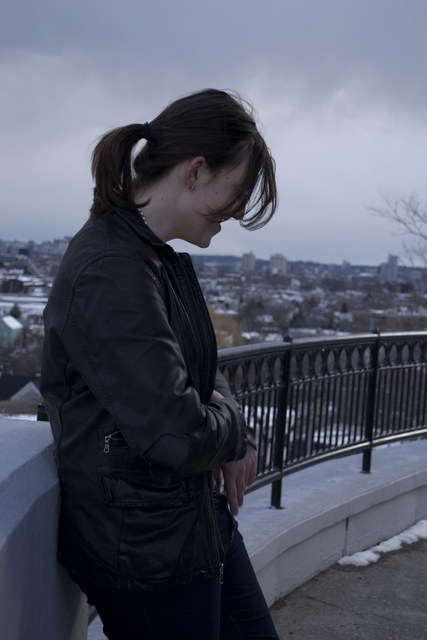
What actually happened was that she showed up and asked why I wasn’t dressed like a woman. I was wearing skinny jeans, a studded belt, and an ironic t-shirt. I liked how I looked. I looked, in my opinion, like a queer woman in her mid-twenties on her day off, which, shockingly, I was.
But no, I was informed, I wasn’t being a woman right.
She was neither the first nor the last person to inform me that I’m doing it wrong. There was I woman I met soon after moving back up to Boston in 2011. She had transitioned in her teens and most folks wouldn’t know she was trans unless she wanted to tell them. She had a real heart for women who were just starting transition, but she had expectations for those people. She couldn’t stand ‘bricks.’ She explained that bricks were women who looked “like a man in a dress.” A cinderblock was even worse. A trans guy who was too femme was feathery.
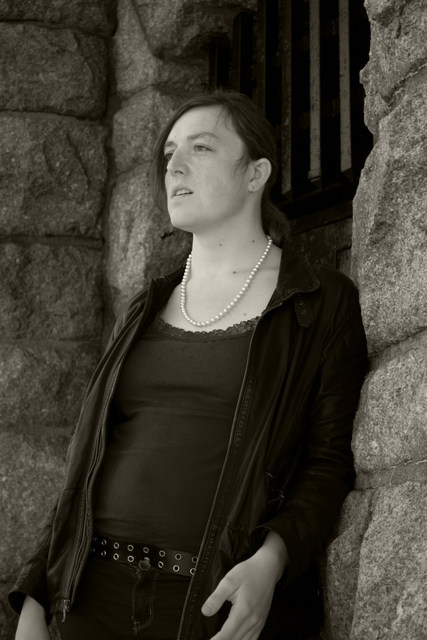
I’ve been told that if I’d only start pitching my voice up, or stop wearing pants, or start wearing make up, I could totally pass, that no one would have to know the shameful secret that I’m a trans person.
There’s another side too. In college I asked the instructor of a Women’s Studies course I took if she could recommend any reading on trans issues. She suggested Sheila Jeffreys’ 2005 book 'Beauty and Misogyny,’ which contains a delightful chapter in which Jeffreys uses pornography depicting young trans women of color to explain why there’s no such thing as trans and how trans women(no mention of trans men or non-binary folks for some reason) are actually evil, essentially pornographic simulacra reinforcing harmful gender tropes.
It’s a great double bind. If you present in a traditionally feminine way, you’re just being a misogynistic parody of a woman, and if you fail to present in a traditionally feminine way, well ha! There’s the proof that you’re not really a woman right there.
And even if you are “really a woman,” that might not be enough. At a Christmas party last December a Smith alumna defended Smith’s decision not to accept trans feminine students by explaining that even if trans women were women, they had still been socialized as boys and men, and that Smith, as a safe space for women and trans men, had a right to defend their students from such people, from the inexorcisable specter of their privilege.
I know women who identify as “heterosexual with a transgender history.” They’re trying so hard to get away.
But you know what’s worse than being somebody’s idea of a bad tranny? Being somebody’s idea of a good tranny, an acceptable tranny.
Last fall I was at an event in a room full of professional acquaintances. A musician who I’ve done some good work with came over to talk to me. This guy is a kind, thoughtful man who I trust. I’ve known him for about two years.
“Vivian,” he said, “it’s so nice to have you here. You always seem to happy and relaxed, and you’re always so open about being trans.”
At this point I’m smiling, enjoying a nice compliment. Then the horror began.
“All the other trans people I’ve known are always so stressed out and unhappy, and are just so difficult. You do an amazing job of making people comfortable.”
And by then I was ready to leap on him to get him to be quiet. The only other trans person he knew, as far as I was aware, was standing a few yards away. I don’t know if she heard that or not, but I really hope not.
That’s not a unique example. I’ve had a lesbian in her 60s tell me that I was the first trans woman who ever got along with, that I’m cool and queer instead of “uncomfortably trying too hard to be a straight woman.”
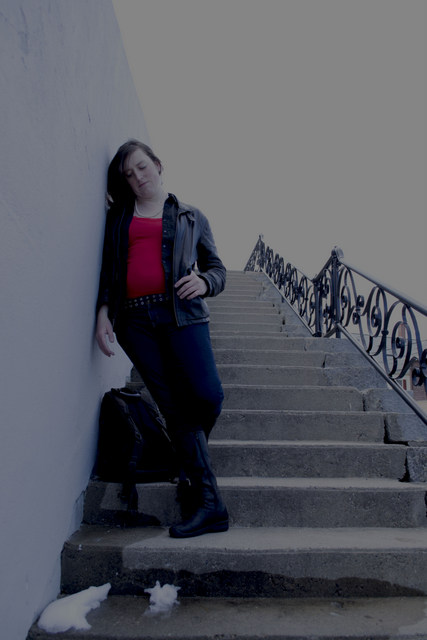
Here’s the thing: People fucking despise trans women. Often the nicest thing they can thing of to say to trans woman is “gosh, you are so little like a trans woman!” Being trans is something to avoid, to exclude, to escape, at worst to nobly bare up under.
But I’m done with it. You can be trans or cis. You can be super femme, you can be ultra butch. You can be straight or queer. You can have people saying you’re a transcendent beauty who just stepped off a Renaissance canvas, you can have people saying you’re a stomach turning monster. You can be a light in the world who every person you meet loves and devotes themselves to, you can be an awkward storm cloud who drives everyone away.
I don’t care. Sun shines and rain falls on the just and unjust alike. I don’t want to know who the Real Good Ones and the Real Bad Ones are. We’re all people. We all deserve to be treated as valued members of humanity. That’s all.
About the Author:
Vivian Taylor is a writer, activist, avid Sung Compline promoter, and proud (if occasionally troubled) North Carolinian currently living in Boston, MA. She served in the War in Iraq from 2009-2010 and is currently process of Discernment for the Priesthood in the Episcopal Church. She writes about her experiences in war, being a peacenik veteran, and being a transgender Christian.
Published by Autostraddle, 5/15/13. All images copyrighted by IVY DALEY.
**CONGRATULATIONS, YOU WON!**
Your stories, your voices, your art, YOU!
‘TESTIMONY: A Living Exhibition of Queer Youth’ at Leslie-Lohman Museum of Gay and Lesbian Art, shared the experiences of LGBTQ young people from all over the world through photography, writing, video and YOUR submitted work. And the show received an award from Fresh Fruit Festival for Outstanding Event of the Year!
Sharing our stories with each other and the community is powerful and we’re so glad you chose to BE HEARD. Coalition for Queer Youth is proud TESTIMONY was honored. You deserve it! ♥
To check out more TESTIMONY or SUBMIT to this award-winning(!) exhibition, visit www.myqueertestimony.tumblr.com
Post link


